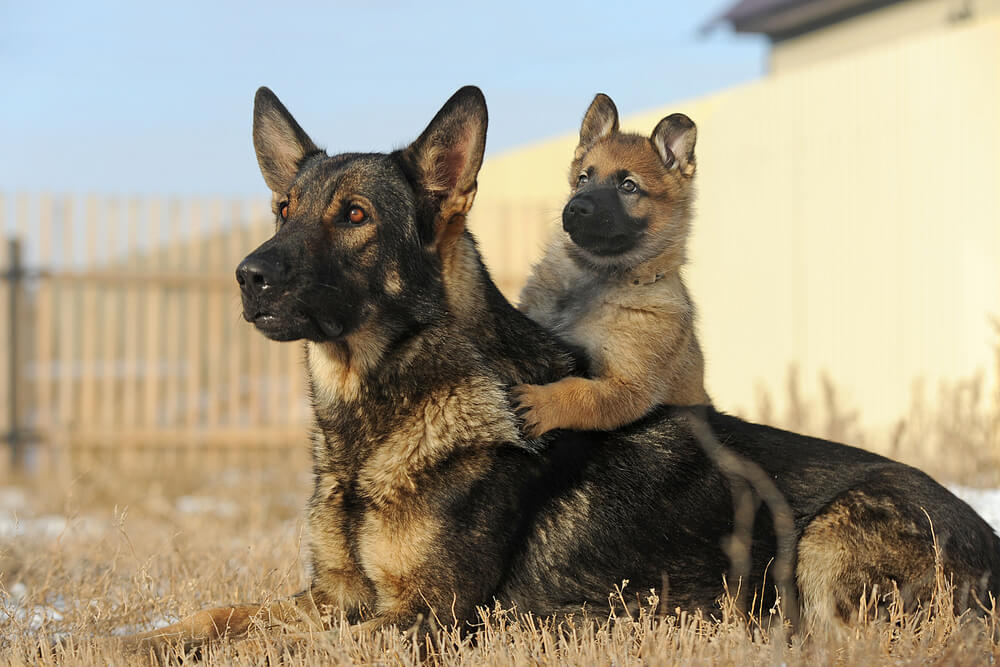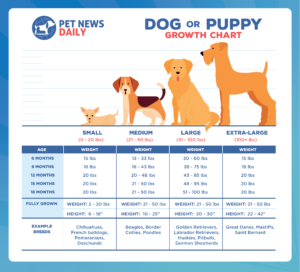Though every breed (and mix of breeds) is different, some general guidelines can help you track your puppy’s growth. We consulted with our veterinarian, Dr. Jennifer Coates, who reviewed and approved data about puppy weights and sizes, which we then used to create a convenient puppy (or dog) growth chart.
In This Article
Puppy Growth Chart
Fully Grown: 21-50 pounds, Height 22-42 inches
Text Transcript of the Puppy Growth Chart
| Dog – Age | Small Weight | Medium Weight | Large Weight | Extra Large Weight |
|---|---|---|---|---|
| 6 months 9 months 12 months 15 months 18 months Fully Grown |
15 pounds 18 pounds 20 pounds 20 pounds 20 pounds Fully Grown 2-20 pounds, Height 6-18 inches |
13-33 pounds 18-43 pounds 20-48 pounds 21-50 pounds 21-50 pounds 21-50 pounds, Height 10-25 inches |
30-60 pounds 38-75 pounds 43-85 pounds 48-95 pounds 51-100 pounds 21-50 pounds, Height 20-30 inches |
15 pounds 18 pounds 20 pounds 20 pounds 20 pounds 21-50 pounds, Height 22-42 inches |
The chart shows you a puppy’s monthly average weight range during the growing phase. You can also refer to the puppy weight calculator to get an idea of how big your puppy is likely to get.
There are few things more exciting than bringing a new puppy home. Those little squirming bundles of fur have a way of stealing into our hearts and we want to do everything we can to help them live long healthy lives.
If you have a new puppy, you may have some questions about his growth. A baby dog, much like a baby person, grows and develops in stages, experiencing exciting changes and transitions at certain times in his life.
You, as the owner, can be sure you’re giving your pup every advantage if you know more about his stages of growth, things that can affect his growth, when he’s likely to stop growing, and how big he’s going to get.
Basic Stages of Puppy Growth
No matter which breed of puppy you have—or even if you don’t know the breed—you can count on some basic stages of puppy growth. The rate of growth, however, will depend on your puppy’s breed type(s), sex (male or female), birth weight, diet, and exercise.1
It’s also important to keep in mind that different dogs pass through development stages at different rates. There are differences between breeds, but also between individuals of each breed. Use the growth chart as a reference, but also speak to your veterinarian if you have any questions about how your puppy is doing.
The most rapid growth in puppies occurs within the first few weeks. From birth to eight weeks old, the puppy will grow faster than at any other point in her life. After that, puppies will experience the fastest growth rate in their first six months.2 Most pups will have reached about 60 percent of their adult height by the time they’re four months old.
Your pup may experience additional growth spurts at any time during her first year or so. Most breeds will become fully grown in 12-18 months, though large breeds can take up to two years or more.
In general, you want to be sure your puppy has the nutrition needed for growth without going overboard. Overweight and obesity in puppies can lead to health problems later in life. A good rule of thumb is to feed puppy-specific foods until your pup reaches full growth, which is usually around 11-14 months of age.
How Big Will a Puppy Get?
You may have heard that a puppy’s paw size can give you an idea of how big your puppy will get. This may help to some extent, but it’s not always accurate. Some breeds—like Bulldogs—naturally have big paws for their size, while others—like Collies—naturally have small paws for their size.
The breed of your dog plays an important role in determining how big she will become. Toy-sized dogs, like Chihuahuas and Pomeranians, normally weigh less than 12 pounds when they’re fully grown. Small dogs like Jack Russell terriers will grow to between 12 and 25 pounds, whereas large dogs like German Shepherds will grow to between 50 and 100 pounds.
Consider too your dog’s gender. As with many other animals, males are typically larger than females.3 The size of the puppy’s parents and other hereditary factors can also come into play. If you got your puppy from a breeder, ask them for information on the puppy’s parents.
If you’re not sure which breed your pup is or if you know they’re a mix of several, you can try this simple formula:4
(Current weight/Age in weeks) x 52.
For example, if your pup is 25 pounds at 16 weeks of age, the formula would look like this:
- (25/16) = 1.57 (rounded up)
- 1.57 x 52 = 82 pounds (rounded up) adult size
This is only a starting point, though. Your puppy’s weight may vary. The best time to use the formula is when your pup is between 12 weeks (for small breeds) and 20 weeks (for large breeds).
You can also use our puppy size predictor to find out how big your puppy might get as an adult. Or, if you want to see the growth rates of other dogs, we’ve also created a Golden Retriever size chart, Great Dane growth chart, Chihuahua size chart, and Labrador growth chart.
How Tall Will My Puppy Get?
Veterinarians don’t often measure height in puppies, so we have an absence of data to accurately determine the stages of height as your puppy advances into adulthood. But the American Kennel Association (AKA) does have height charts for each breed of dog, so you can refer to that if you have a purebred dog, or use it to get a general idea if you have a mixed-breed dog.5
When Will My Puppy Stop Growing?
The amount of time it takes for your puppy to reach full growth depends greatly on his breed. Smaller dogs can reach maturity between six and eight months, and certainly will be full grown by 12 months. Larger dogs can take anywhere from 12 to 24 months to reach their full size, whereas giant breeds like the Great Dane can take up to two-to-three years.
As a general rule, small and medium puppies will finish growing at around half the age of their larger counterparts.6
Things That Affect Growth
The most important factors that will affect how your puppy grows are diet and exercise. With the proper nutrition, puppies are more likely to develop as they should, growing strong teeth and bones, a healthy coat, good vision, sturdy muscles, and lots of energy. Exercise also helps them burn calories and develop their muscles and bones.
Choose a balanced, nutritional puppy food for your best friend, as a deficiency in any essential nutrient can compromise a puppy’s health. Next, make sure your puppy is getting the right number of calories. Underfeeding can compromise growth while overfeeding can lead to excessive weight gain.
Monitor your puppy’s weight and body condition score (the dog equivalent of body mass index or BMI), and then adjust your puppy’s food intake as needed.7
You can check your puppy’s progress by feeling its ribs. If you can feel them but not see them, you’re probably in good shape. The ribs should be covered with minimal fat and you should be able to see the dog’s waist curve when you look at him from above. Giving your dog daily exercise will help him maintain a healthy weight.
If your dog is not gaining weight like you think he should check with your veterinarian. Some health problems, congenital defects, and other issues could be affecting his growth.
Puppy Weight Calculator
PUPPY WEIGHT CALCULATOR
Frequently Asked Questions
How can you tell how big a puppy will get?
To determine how big your puppy will be when she is fully grown, consult our puppy weight calculator above. You can also use this formula when your pup is between 12 and 20 weeks to get a general idea.
(Current weight/Age in weeks) x 52.
Your dog’s breed, parents, and gender also play a role in how big he will get. Use this information to estimate your dog’s final size.
Puppies experience the fastest growth between birth and 8 weeks old. After that, they continue to grow quickly until they reach six months of age. Growth slows down then, but depending on the breed, may continue for up to two-to-three years.
Small breeds will experience growth spurts sooner than larger breeds. Their weight at two months may double at four months. After that, their growth will slow. Larger breeds tend to experience more steady, faster growth during the first 5-6 months, after which the rate of growth will taper off.
Though paw size can give you some indication of how large your dog will be, it’s not always an accurate measurement. Some breeds (like Collies) have small paws for their size, while others (like Bulldogs) have large paws for their size. So use this measurement only as a general indicator.
Paw size is also more likely to help you determine the adult size in purebred dogs. Mixed breeds can be trickier. Wait until the dog reaches around three months of age. At that point, the paw size will be pretty proportionate to their overall size.
If the size of the parents is about the same, the female pups will grow to the size of their mothers, while male pups will more closely resemble the size of their fathers. If the parents are of different sizes, though, the puppy will likely end up somewhere between the two.
In addition to looking at the puppy’s parents, her breed, and her paw size, you can also use a formula that Wisdom Panel veterinarians recommend: Multiply your pup’s weight at four months by two to get an estimate of their adult weight. If your dog’s weight at four months is 20 pounds, her adult weight may be around 40 pounds. (https://www.wisdompanel.com/en-us/blog/predicting-puppy-size-potential)
This depends on what you’re figuring as the start weight. A small dog can weigh twice as much at four months as he did at two months. Most small dogs reach their adult weight between 6-8 months. Larger dogs take longer to grow. For them, their six-month weight is typically about two-thirds of their adult weight.
Additional Resources
If you’re looking for more information about dog growth in general, we’ve created a puppy weight calculator, an in-depth guide to how heavy your dog should be, and a series of growth charts for different breeds (and dogs and mixed breeds in general):
- Great Dane Growth Chart
- Goldendoodle Growth Chart
- Chihuahua Growth Chart
- Golden Retriever Growth Chart
- Labrador Growth Chart
- Dog Growth Chart
- Mixed Breed Growth Chart
- Rottweiler Growth Chart
- Pit Bull Growth Chart
- Australian Shepherd Growth Chart
- French Bulldog Growth Chart
- Great Pyrenees Growth Chart
- Standard Poodle Growth Chart
- Bernedoodle Growth Chart
- Husky Growth Chart
Article Sources
Pet News Daily uses only high-quality sources, including peer-reviewed studies, to support the facts within our articles. Read our editorial process to learn more about how we fact-check and keep our content accurate, reliable, and trustworthy.
- Hawthorne, A. J., Booles, D., Nugent, P. A., Gettinby, G., & Wilkinson, J. (2004). Body-weight changes during growth in puppies of different breeds. The Journal of Nutrition, 134(8), 2027S-2030S. https://doi.org/10.1093/jn/134.8.2027s
- Staff, A. (2020, March 3). Proper puppy nutrition nourishes rapid growth & development. American Kennel Club. https://www.akc.org/expert-advice/health/proper-puppy-nutrition-nourishes-rapid-growth/
- Staff, A. (2020, March 3). Proper puppy nutrition nourishes rapid growth & development. American Kennel Club. https://www.akc.org/expert-advice/health/proper-puppy-nutrition-nourishes-rapid-growth/
- Puppy growth: What you need to know. (n.d.). Bond Vet. https://bondvet.com/b/puppy-growth
- Dog breeds – Types of dogs – American Kennel Club. (n.d.). American Kennel Club. https://www.akc.org/dog-breeds/
- Paretts, S. (2021, August 10). When does my puppy finish growing? How long do puppies grow? American Kennel Club. https://www.akc.org/expert-advice/health/when-does-my-puppy-finish-growing/
- Body condition scores | VCA animal hospital. (n.d.). Vca. https://vcahospitals.com/know-your-pet/body-condition-scores


